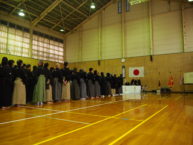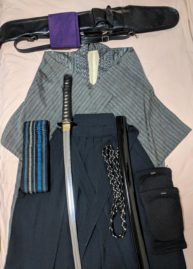Iaidô is a sport —and an art— that I’ve wanted to learn since I first heard of its existence several years ago as a freshman in college. The fluid power and steady grace of iaidô practitioners’ movement transfixed me as I replayed YouTube videos and followed along as best I could as swords flashed through the air.

Presentation of members before the grand master at a joint gathering of dojos
When I learned that I had been accepted into the KCJS program with its Community Involvement Project (CIP) requirements for us students, my top pick for the CIP was very obvious. With the assistance of the teachers and staff, I was able to find and join an iaidô dôjô in nearby Hirakata city and soon found myself immersed in a vibrant, close-knit community of martial arts enthusiasts. The people I met there have been nothing short of kind and helpful, making sure that, even with the language barrier, I am able to make it to practices and luncheons every week (the dôjô has no physical presence and as a result, practices are held at a different community center each weekend), and they have even included me in the carpool system that ensures members of all ages and locales are able to arrive on time.
Putting on the iaidô uniform proved to a ready catalyst for bonding among myself and the other female members. We all chuckled good-naturedly over my utter confusion as I attempted to wrangle a kaku obi —a stiff cloth wound around the waist to hold the sword

From top to bottom, left to right: sword carrying case; cloth sword cover; kimono; hakama; kaku obi; iaitô; sheath; knee pads
and belt the kimono— into place and keep my hakama —wide-legged pants— in place throughout the three-hour practices. This same uniform also quickly proved to be my biggest reminded of the kindness and generosity of my dôjô-mates. Every time I look in the mirror of the community center’s practice hall, I see the soft gray of my kimono, the heavy black cotton of my hakama, and the lacquered sheath of my iaitô —a blunt-edged sword— and am reminded of how these items were either gifted or loaned to me so that I could practice with the proper equipment from day one. For example, when we figured out that the iaitô I had been using was hindering me because of the length, a member volunteered his extra iaitô that was short enough for someone with my five-foot-even stature to wield.
As with any new sport, I had to learn a whole new way of moving and then how to control each of these motions —such as the initially awkward motion of drawing a sword— in a process that, unsurprisingly, had its hiccups. One such instance is how I, unused to the wide flowing sleeves of my kimono, have a tendency to catch the hilt of my iaitô in the cuff while drawing. In response, the elder gentleman who oversees my training paused the lesson and carefully explained to me how to remedy the problem with a needle and thread when I got home by making the sleeve opening smaller and so allowing me to move more freely. Moments like this, where help and instruction are so readily offered with a smile and steady patience, have come to define my time at the iaidô dôjô and I wear the reminder of my dôjô-mates’ kindness every time I step out onto the mats alongside them.

You say the community was close knit, do you feel like you’ve been successfully brought into the fold?
I believe so! I’ve become a regular part of the post-practice outings that the college-aged students will sometimes organize (think dinners or going to view the fall foliage during the autumn illuminations at Kiyomizu-dera)